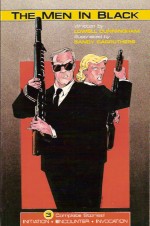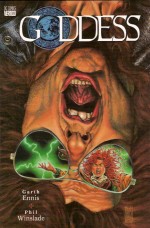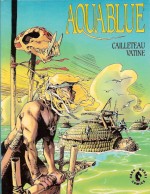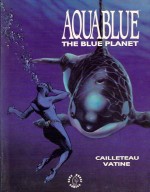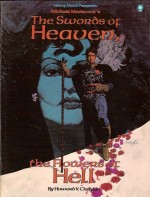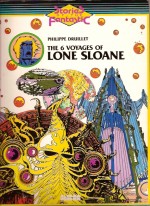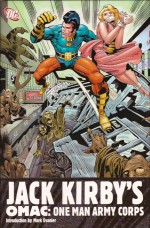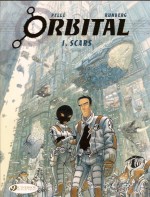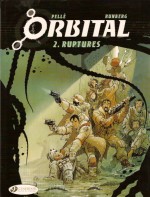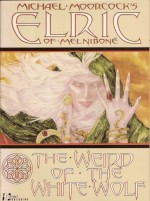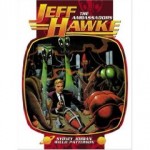
By Sydney Jordan & Willie Patterson (Titan Books)
ISBN: 978-1-84576-598-9
One the world’s most captivating comics strips is inexplicably almost unknown amongst modern readers, but this appalling state of affairs could so easily be rectified simply by purchasing this spiffy deluxe hardback from Titan Books – and its predecessor – and falling under the spell of some of the most witty, intriguing and outright astounding British science fiction ever written or drawn. In both style and quality these superb tales from the 1960s are the only serious rival to the legendary Dan Dare these Sceptred Isles have ever produced.
Sydney Jordan began his saga of the thinking man’s hero in the Daily Express on February 2nd 1954, writing the first adventures himself. In 1956 his old school friend and associate Willie Patterson moved from Scotland to London and helped out with the fifth adventure ‘Sanctuary’, and scripted the next one ‘Unquiet Island’, whilst sorting out his own career as a freelance scripter for such titles as Amalgamated Press’s Children’s Encyclopaedia, Caroline Baker – Barrister at Law and eventually Fleetway’s War Picture Library series.
Syd was never comfortable scripting, preferring to plot and draw the strips, but his choice of collaborators has always been immaculate – Harry Harrison wrote ‘Out of Touch’, which ran from October 10th 1957 – April 5th 1958, Nick Faure and Martin Asbury worked with him in the 1970s and in the strips’ final days he hired young artists Brian Bolland and Paul Neary. Patterson continued to supplement and assist Jordan intermittently until 1960 until with the fourteenth tale ‘Overlord’ (see Jeff Hawke volume 1: Overlord) Patterson assumed the writing chores on a full-time basis and began the strip’s Golden Age. He remained the wordsmith-in-chief until 1969.
This volume opens with another fascinating memoir from Jordan himself before the wonderment begins. In ‘Pastmaster’ (August 3rd 1961-October 18th 1961) British Space Scientist and trouble-shooter Hawke is visiting the British Moonbase just as a crazed time-traveller from the future materialises intent on changing history by transporting the entire complex back 10,000 years, and giving humanity a huge technological jump-start in the race’s development.
A terrific mix of sly comedy and startling action in the inimitable, underplayed style of Nigel Kneale’s Quatermass and the best of John Wyndham, this romp of time-cops and robbers is a splendid appetiser for ‘The Immortal Toys’ (October 19th 1961- 5th April 1962) wherein ancient Hindu jewels in the shape of insects are revealed to be something else entirely, leading Hawke and a rambunctious archaeologist reminiscent of the bombastic Professor Challenger to a long-hidden tomb and concrete evidence of alien visitors from Earth’s earliest pre-history. No fan of Indiana Jones would want to miss this yarn – especially as here all the science, history and stunts are both plausible and possible…
‘The Ambassadors’ (6th April 1962-13th July 1962) is a winningly clever social satire as two avian aliens looking just like owls arrive in London to offer Earth free, gratis and for nothing a device that will do away with work forever. Instantly politicians and the media descend like vultures and the dry self-deprecatory comedy of films like The Mouse That Roared as well as the works of Jonathan Swift, Robert Sheckley or Eric Frank Russell can be seen in this story exposing the worst of humanity.
Patterson could use humour like a scalpel and augmented by Jordan’s fantastic artwork and rich, incisive facility with expressions produced here a gentle satire to rival the best of Private Eye, Tom Lehrer or TW3. You’ll believe an owl can cry…
Sheer exotic adventure and High Concept science dominates ‘The Gamesman’ (14th July 1962- September 23rd 1962) as a bored alien uses sub-atomic worlds for role-playing diversions, snatching Hawke and his assistant, a giant warrior, a technical wizard and a feisty “princess†from their respective worlds to play with him. Unfortunately ambition is a universal problem and the extraterrestrial dungeon-master quickly finds himself “playedâ€â€¦
The last tale in this volume is another human-scaled fable that touched on contemporary concerns, but although humour is still present in ‘A Test Case’ (September 24th 1962- 2nd January 1963) the over-arching theme is nuclear terror, as a second-rate scientist is given ultra-advanced atomic knowledge by well-meaning aliens who have no idea how fragile a human mind can be…
The frantic desperation and tension as Hawke and the authorities search London for a super-nuclear device primed to eradicate them all is chillingly reminiscent of the Boulting Brothers 1950 film classic Seven Days to Noon and makes of this memorable tale a timeless salutary warning.
These are stories that appeared in daily episodes and their sardonic grasp of the true nature of “the man-in-the-street†make them a delightful slice of social history as well as pure escapist entertainment. Jeff Hawke is a revered and respected milestone of graphic achievement almost everywhere except his country of origin. Hopefully this latest attempt to revive these gems will find a more receptive audience this time, and perhaps we’ll even get to see those earlier stories as well.
© 2008 Express Newspapers Ltd.

